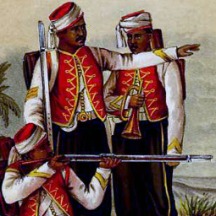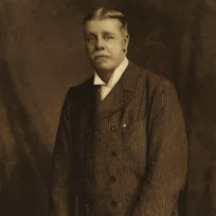After the British outlawed the trading of enslaved Africans, the British pursued lawbreakers and ships containing now illegal human cargo, had their valued goods confiscated, and sent back to Africa, mainly Sierra Leone. However, during this “repatriation” era, some 2,400 “liberated Africans” landed on MacCarthy Island, The Gambia.
In 1807, Britain formed the settlement of the Gambia, which the crown governed out of Sierra Leone until 1843, when the British govern them as one again from Sierra Leone. It’s fair to say that Sierra Leone’s leaders have not been like Iraq’s Saddam Hussein. In 1990, Hussein invaded Kuwait with the claim that the Sheikhdom of Kuwait was a part of Iraq until the British created Kuwait.
Surprisingly, I learned of the West Indian Regiment and that battles were not restricted to African versus African, Europeans versus Europeans, or Africans versus Europeans, but also West Indians versus Africans . . .
In 1823, Kolli Kamara, king of Kataba (lower Niani) ceded MacCarthy Island to the British, who built Georgetown there. A dispute ensued when the colonists demanded labor from Niani, but Kamara sent an army, forcing the British to take refuge in their fort.
1831, the British created a Liberated African Department at McCarthy Island and Oyster Creek in the Kombos, near the Atlantic Ocean. In 1841, the British stationed 173 soldiers on the Island, soldiers from the West Indian Regiment. Surprisingly, I learned of the West Indian Regiment and that battles were not restricted to African versus African, Europeans versus Europeans, or Africans versus Europeans, but also West Indians versus Africans and that a contingent from the Regiment retired there while others chose Newcastle, The Gambia or St. Vincent, West Indies, circa 1841.
On March 3, 1834, people of Wuli and Nianhautang went to McCarthy Island, burned government buildings and the homes of liberated Africans. “The marauders had retired, carrying off numbers of people for slavery and a large quantity of cattle,” reports Francis Bisset Archer Archer in "The Gambia Colony and Protectorate An Official Handbook," circa 1906. However, unlike Ogun, such actions keep me from coming close to seeing Africans as having been coerced into the Atlantic slave trade.
In May 1853, three West Indian Regiments, Gambia Pensioners, and the colony’s militia, 603 men, seven guns, a mortar, and rocket tube left Bathhurst (now Banjul) via Jeshwang and completely destroyed Sabijee. What made this struggle even more complex than Hollywood would make it, is that during a struggle in July 1855, a Moor led Sabijee and a French force of 80 men joined the British.
All of the fighting kept the British in control. In 1858, Queen Elizabeth granted a patent for some British to conduct trade in Senegambia, which is Senegal and Gambia combined. In 1888, the British again split Sierra Leone and Gambia and the current boundaries of the Smiling Coast of Africa began to take shape.
On August 10, 1889 the Boundary Commission signed the agreement which laid the line of demarcation between the English and French which created the boundaries of current day Senegal and Gambia.
“In 1891, the (Boundary) Commission proceeded at once with its work, but received repeated checks from both Fodi Sillah and Fodi Kabba, in consequence of which British gunboats had to patrol the river to near where the Commission was engaged,” continued Archer. The Jolahs told the British that the Fodi Kabba was to attack.
On January 2, 1892, Marigo, Bondali, and the adjacent villages were totally destroyed. The 100 man, plus three officers, including a European non-commissioned officer, West Indian Regiment was permanently stationed in the colony. The Boundary Commission completed its work in 1899.
“Having been born in slavery they know no other condition; and, seeing that they are well cared for by their masters and treated practically as outside members of the family, they consider themselves well off.”
Though fact checker Politifact says Harriet Tubman never said she could have freed more slaves ‘if only they knew they were slaves’, Archer did write about traditional African house slaves (versus those captured during war), “Having been born in slavery they know no other condition; and, seeing that they are well cared for by their masters and treated practically as outside members of the family, they consider themselves well off.”
Join POH For Tobaski2025
The specifics evolve depending upon flight schedules from the US and those from Dakar. The option of going by land between the capital cities, Dakar and Banjul, depend upon the flight schedules and the number of travelers.
Here is the preliminary itinerary
Support for Port of Harlem magazine
Like many publications, including the famed AP, our advertising revenue is not keeping pace with expenses. If you have not donated to our non-profit or have not become a POH Podcast supporter, we ask you for a donation. If you want to see more stories such as this one, please donate now. No amount is too little.








